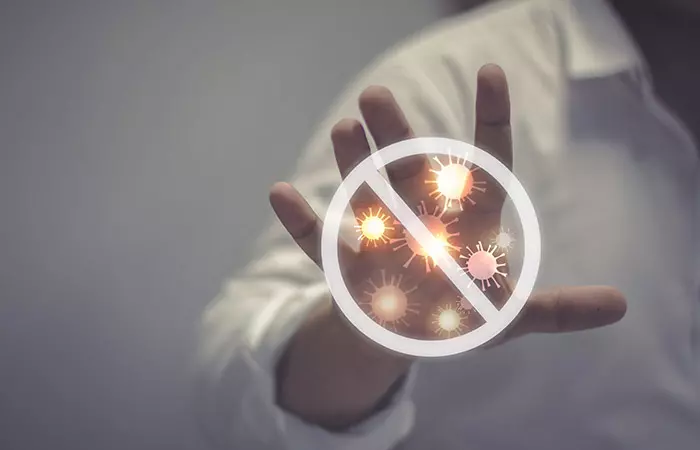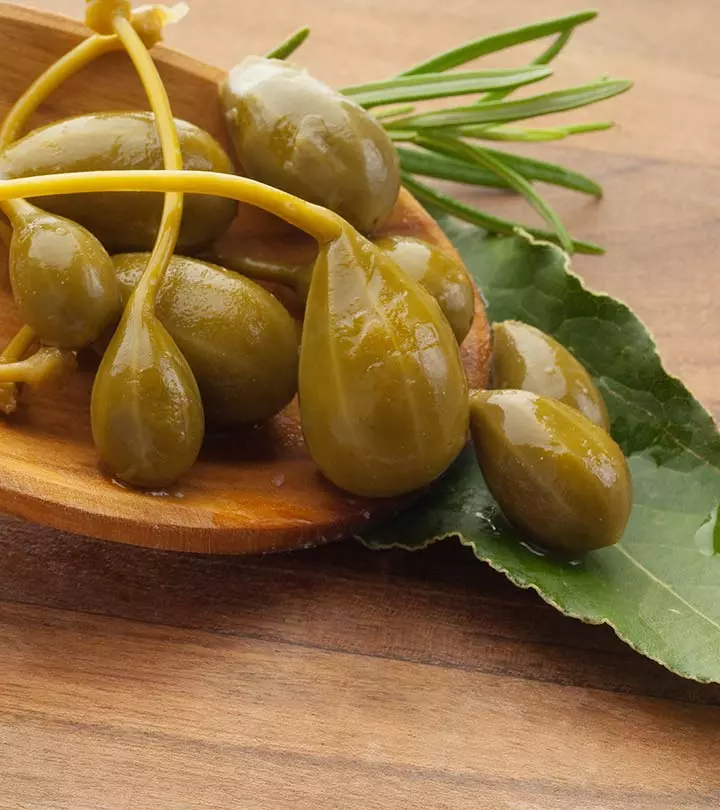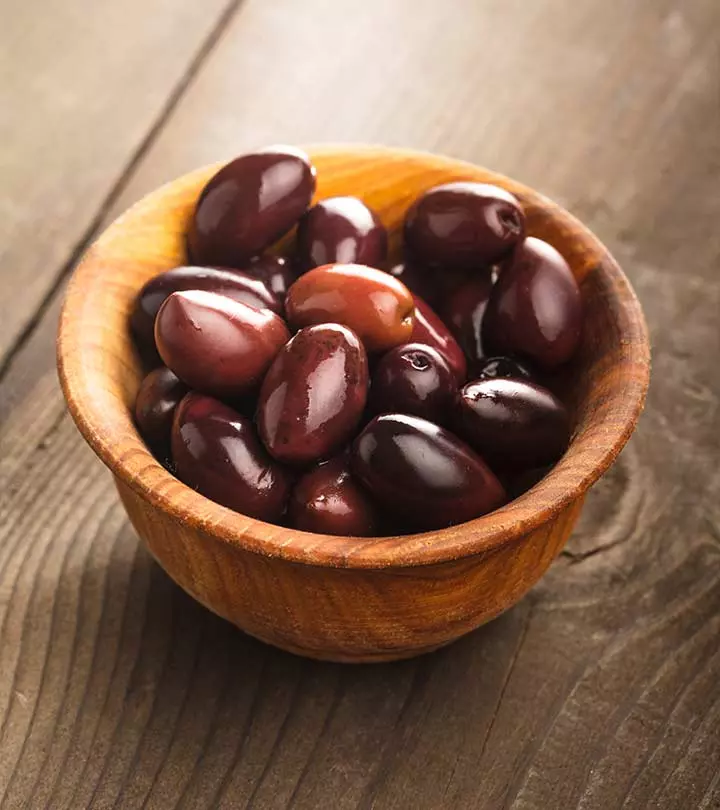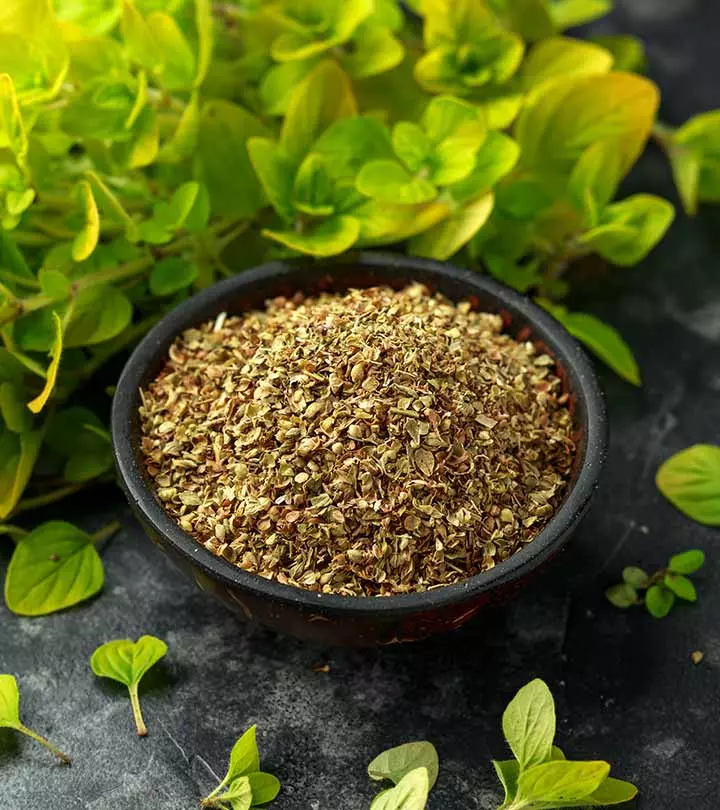Is Swordfish Healthy? Benefits, Recipes, And Side Effects
Boost your heart health and promote brain function with this delicious fish!

Image: iStock
Swordfish are large predatory fish with a rich nutrient profile. Their steaks are more popular in the South Atlantic region. The benefits of swordfish are numerous, thanks to their omega-3 fats, vitamin D, and selenium. These nutrients help support your heart health, bone strength, and cognitive function. This predatory fish can reach a length of 15 feet and can weigh several pounds. This article explores the nutrition facts, health benefits, and some popular recipes of swordfish that you can try. Keep reading.
 Know Your Ingredient: Swordfish
Know Your Ingredient: SwordfishWhat Is It?
A large, predatory fish with a long, pointed bill that is found across the Pacific, Atlantic, and Indian ocean.
What Are Its Benefits?
May support heart health, increase brain function, and improve vision and bone health.
Who Can Consume It?
Considered safe for consumption in general.
How Often?
Up to 250 mg daily.
Caution
Avoid consuming it if you are allergic to seafish. May aggravate diabetes due to high mercury content.
In This Article
What Is Swordfish?

Swordfish (Xiphias gladius) is a large, migratory, predatory billfish found in warm and temperate waters of the Atlantic, Pacific, and Indian oceans. It has a rounded body, large eyes, and a long sword-like bill to injure and stun the prey. Adult swordfish lack teeth and scales.
Swordfish is a popular game fish pursued by anglers for recreational and commercial activity. Anglers commonly use longlines and harpoons to catch them. Swordfish migrate to colder waters in the summer to feed. Fish and invertebrates like squid are among their preferred meals.
 Trivia
TriviaSwordfish meat (or steak) is sold fresh or frozen, and accordingly, the nutritional value may vary. Check out the standard nutritional information of swordfish below.
Key Takeaways
- Swordfish are found in warm waters of the Atlantic, Pacific, and Indian oceans.
- They are an excellent source of selenium and vitamin D, nutrients the human body cannot produce.
- Swordfish contains vitamin D, which is crucial for bone health. This vitamin may also reduce the risk of colon, breast, prostate, and ovarian cancers, and promote immunity and heart health.
Nutrition Profile Of Swordfish
A hundred grams of raw swordfish contains (1):
| Calories | 144 kcal |
| Proteins | 19.7 g |
| Total lipids (Fat) | 6.65 g |
| Sodium | 81 mg |
| Potassium | 418 mg |
| Calcium | 5 mg |
| Iron | 0.38 mg |
| Magnesium | 29 mg |
| Phosphorus | 255 mg |
| Zinc | 0.66 mg |
| Selenium | 57.4 µg |
| Vitamin D | 13.9 µg |
| Vitamin E | 2.02 mg |
| Cholesterol | 66 mg |
Swordfish is rich in omega-3 fatty acids, particularly EPA (eicosapentaenoic acid) and DHA (docosahexaenoic acid) (2). It is an excellent source of selenium and vitamin D. Human body cannot produce these essential nutrients. Hence, we have to depend on food sources to get them. Consuming swordfish has excellent health benefits. However, if you are still wondering, ‘Is swordfish healthy? Then let’s take a look at its benefits.
Potential Health Benefits Of Swordfish
1. May Promote Heart Health

Swordfish contains selenium, vitamin D3, and omega-3 fats. Selenium is crucial for maintaining heart health, especially in patients at the risk of heart failure and cardiovascular conditions. Vitamin D3 maintains healthy blood vessels and heart function. Several clinical trials have shown that EPA and DHA reduce the risk of heart-related deaths, and a daily intake of 0.5 to 1.8 g of EPA and DHA keeps the heart healthy. The EPA and DHA may lower blood pressure and improve blood vessel function and heart health (3), (4), (5 ).
2. May Prevent Cancer
Omega-3 fatty acids and vitamin D have anti-inflammatory properties that may help reduce the risk of cancer (especially colorectal cancer) (6). Both these nutrients may also help keep the cancer cells from spreading inside the body, (7).
3. May Boost Brain Function

The essential nutrients in swordfish may help boost brain function and cognitive abilities. Vitamin D promotes brain development and function. Balanced blood and brain selenium (present in swordfish as selenoproteins) concentrations are essential for healthy brain function and neuron survival. DHA is also vital for brain function and improved cognition (8), (9), (10).
4. May Improve Vision
EPA and DHA reduce the risk of inflammatory eye disorders, such as dry eye disease (DED) and age-related macular degeneration (AMD). These healthy fats reduce inflammation and protect our eyes (11).
5. May Improve Bone Health

Swordfish is packed with nutrients that can keep your bones strong and healthy. Vitamin D helps keep calcium and phosphorus levels in check, the bones strong and hard, and maintains essential cellular functions. Selenium (as selenoproteins) promotes bone development, and omega-3 fatty acids may increase bone mineral density in women (12), (13), (14).
6. May Manage Rheumatoid Arthritis
Researchers found that a daily dose of 2.6 g omega-3 fatty acids could minimize the symptoms of rheumatoid arthritis. In addition, women over 50 may be at lower risk for rheumatoid arthritis when they consume adequate amounts of vitamin D (15), (16).
7. May Boost Immunity

Omega-3 fatty acids improve the function of immune cells to improve the body’s immune response. Vitamin D also influences immune system response and reduces the risk of infections and other diseases. Selenium affects immunity in different ways. In individuals with moderately low selenium levels, it may have a greater impact on immune function (17), (18), (19).
8. May Help In Calcium Absorption
Swordfish may improve calcium absorption in the body due to its vitamin D content, a key factor in calcium metabolism. Adequate levels of vitamin D are essential for optimizing the efficiency of calcium absorption. Without it, the body can only absorb 10-15% of dietary calcium, but with enough vitamin D, absorption may increase to 30-40%. In studies with rodents, those lacking vitamin D receptors developed osteomalacia, a bone condition, that could be reversed with a diet rich in calcium and lactose. This highlights vitamin D’s crucial role in promoting proper bone mineralization by enhancing calcium absorption in the intestines (20).
Though the above benefits seem brief, their role in our body’s functioning is complex. Numerous biological processes rely on the three vital nutrients – omega-3 fats, selenium, and vitamin D. And swordfish is a wholesome source for all. Get the details on how to include swordfish in your diet in the next section.
How To Add Swordfish To Your Diet: Popular Recipes
Swordfish is a popular and delicious seafood often featured in Mediterranean cuisine. It has delicate, tender, and moist meat with a hint of sweetness. It is usually grilled, broiled, or pan-seared. Well-cooked swordfish is crisp yet tender. Here are a few recipes you can try.
Popular Recipes With Swordfish
1. Greek Stuffed Swordfish
This hearty swordfish recipe is infused with Mediterranean flavors.
What You Need
- 200 g swordfish steak
- 1 tablespoons of olive oil
- 1 tablespoon of fresh lemon juice
- 2 cups of fresh spinach (chopped)
- 1 clove of garlic (minced)
- ¼ cup of feta cheese (crumbled)
- Salt, as needed
- Black pepper (freshly ground), as needed
How To Prepare
- Set up an outdoor grill on high heat. Lightly oil the grate.
- Slit the steak to make a pocket.
- Combine a tablespoon of olive oil and lemon juice in a cup. Brush both sides of the steak with the mixture and keep it aside.
- Heat a teaspoon of olive oil and garlic in a small skillet over medium heat. Add spinach and wilt it.
- Remove from heat and stuff the spinach and feta cheese into the pocket.
- Grill the fish for 8 minutes on each side.
- Cook until done and season with salt and pepper.
 Trivia
Trivia2. Tangy Grilled Swordfish
This tangy swordfish dish will have you coming back for more.
What You Need
- 2 pieces of 200g swordfish steaks
- 2 garlic cloves (thinly sliced)
- ½ teaspoon of saffron threads
- 12 cherry tomatoes (halved)
- ¼ cup of chives
- ½ cup of parsley (coarsely chopped)
- ½ cup of olives (mashed)
- 1 tablespoon of red wine vinegar
- 2 teaspoons of vegetable oil
- Salt, as needed
- Black pepper (freshly ground), as needed
How To Prepare
- Oil the grill grates and set the heat to medium-high.
- Coat the steaks with salt and oil.
- Sauté garlic and saffron on medium-high heat for two minutes. Transfer to a bowl and set aside.
- Grill the steaks for 5 minutes until opaque and firm. Plate them.
- Toss tomatoes, chives, parsley, olives, and vinegar into a bowl with the reserved garlic mixture, salt, and pepper.
- Serve with the fish steaks.
3. Swordfish With Mushrooms
This delicious swordfish dish paired with earthy mushrooms will keep your taste buds tingling.
What You Need
- 2 pieces of 200g swordfish steaks
- 1 tablespoon of olive oil
- 4 tablespoons of unsalted butter
- 1 ½ cups of mushrooms (sliced)
- 3 tablespoons of lemon juice
- 1 green onion (sliced)
- 1 tablespoon of dry white wine
- 1 tablespoon of capers
- 2 tablespoons of parsley (chopped)
- Salt, as needed
- Black pepper (freshly ground), as needed
- 1 tablespoon of lemon zest
How To Prepare
- Preheat the oven to 400°F.
- Brush the swordfish with olive oil and season both sides with salt and pepper.
- Sear the fish for a few minutes on each side over high heat.
- Remove it from the heat and put it in the oven for 10 minutes.
- Melt butter in a separate skillet over medium heat. Sauté the mushrooms, green onions, lemon juice, and zest with a splash of white wine.
- Sauté for 5-6 minutes, or until the mushrooms are tender and the sauce is dry. Add salt and pepper to taste.
- Slice the swordfish and top with mushrooms, capers, and parsley.
Here are some additional tips for cooking swordfish:
- If you are looking for fresh fish, check for color clarity and resistance. Ideally, the meat should be bouncy.
- Ensure to remove the skin before cooking.
- Always thaw frozen swordfish.
- The fish turns opaque as it cooks. Flip it once you see it turning white.
Angela, a blogger, shared her experience about preparing a swordfish dish that she had at a restaurant in her blog. She said, “I enjoyed a roasted swordfish with peppers that was so moist (i).” However, she tweaked the recipe a little. She said, “The lemon slices and potatoes are my additions to what I remember from that restaurant meal.”
The swordfish is a fantastic ingredient to experiment on with different marinades, as its firm texture and mild flavor pair well with a variety of seasonings and spices.
Here are some simple ideas for marinating and seasoning swordfish:
- Mix fresh lemon juice, olive oil, garlic, and herbs like thyme or rosemary. Let the swordfish sit in this for 15-30 minutes for a fresh, zesty flavor.
- Combine diced garlic, soy sauce, honey, and a little grated or mashed ginger. This adds a sweet and savory taste to the fish.
- If you like a bit of heat, marinade the swordfish in Cajun seasoning, paprika, garlic powder, and a pinch of cayenne pepper.
- For a more classic approach, simply season the fish with salt, pepper, and a drizzle of olive oil before grilling.
A drizzle of balsamic vinegar right before serving can bring out a rich, tangy flavor.
Feeling inspired to try these tasty swordfish recipes? Before you do, consider these factors.
Side Effects And Allergies
Swordfish is packed with essential nutrients and health benefits. The concern, however, is that it may also contain high levels of mercury.
Apex predators like swordfish feed on various other fish and thus, accumulate high levels of mercury, especially methylmercury. This toxin may cause cancer and adversely affect the brain (21).
Species of fish that live for long and are on the top of the food chain (apex predator) contain high levels of mercury than other fish. Regular consumption of such fish can cause mercury poisoning. While the body naturally disposes methylmercury, its levels may take over a year to drop significantly. Therefore, the FDA and Environmental Protection Agency (EPA) advise pregnant women, nursing mothers, and young children to avoid these types of fish (22).
Don’t get alarmed. Most sea fish contain some amount of methylmercury. Instead of avoiding them, limit your consumption. Be sure to consult your doctor.
Infographic: 5 Most Impressive Swordfish Health Benefits
Swordfish offers a delectable taste and provides many essential health benefits. The best way to gain all of its benefits is to either grill or bake this fish. We would like to bring your attention to the top 5 advantages of adding this delicious fish to your diet. Check out the infographic below to read through the top 5 benefits of consuming swordfish.

Illustration: StyleCraze Design Team
Swordfish is a large predator fish with a distinct nutritional profile. It is rich in selenium, omega-3 fatty acids, and vitamins. These nutrients are responsible for the many benefits of swordfish. The intake of swordfish may promote heart health, boost brain function, improve vision, and increase bone mineral density in women. However, high mercury levels in this predator fish may increase cancer risk and negatively impact the brain. Hence, consume swordfish in moderation and enjoy its health benefits.
Frequently Asked Questions
Is swordfish fatty or lean?
Swordfish is a fatty fish loaded with omega-3 fatty acids.
Do swordfish have worms?
Yes, swordfish meat may have worms. Hence, cleaning it properly before consuming is essential.
Can people with diabetes eat swordfish?
Yes, people with diabetes can have swordfish – but only in limited quantities. As per the American Diabetes Association, swordfish has high levels of mercury that may aggravate diabetes.
Is swordfish similar to tuna?
No. Though the taste profile and some of the health benefits of tuna may be similar to that of swordfish, they are different.
Is frozen swordfish as good as fresh?
Yes, frozen swordfish is as good as fresh. However, the fish should be frozen properly to preserve its taste and nutrients.
Illustration: Is Swordfish Healthy? Nutrition Recipes Side Effects And More

Image: Stable Diffusion/StyleCraze Design Team
Discover some tips and techniques for cooking swordfish. Watch this video for simple steps on how to cook this delectable fish for your upcoming meal.
Personal Experience: Source
StyleCraze's articles are interwoven with authentic personal narratives that provide depth and resonance to our content. Below are the sources of the personal accounts referenced in this article.
i. Roasted Swordfish with Red Peppers and Onionshttps://myworldwithoutwheat.com/category/swordfish/
References
Articles on StyleCraze are backed by verified information from peer-reviewed and academic research papers, reputed organizations, research institutions, and medical associations to ensure accuracy and relevance. Read our editorial policy to learn more.
- Fish, swordfish, raw, FoodData Central
https://fdc.nal.usda.gov/fdc-app.html#/food-details/173703/nutrients - Seasonal Effects on the Levels of Omega 3 Fatty Acids in Swordfish (Xiphias Gladius) Muscles According to Body Parts
https://www.researchgate.net/publication/270683826_INTERNATIONAL_JOURNAL_OF_ENGINEERING_SCIENCES_RESEARCH_TECHNOLOGY_Seasonal_Effects_on_the_Levels_of_Omega_3_Fatty_Acids_in_Swordfish_Xiphias_Gladius_Muscles_According_to_Body_Parts - Selenium and outcome in heart failure
https://onlinelibrary.wiley.com/doi/full/10.1002/ejhf.1644 - Vitamin D in the prevention and treatment of coronary heart disease
https://journals.lww.com/co-clinicalnutrition/Abstract/2008/11000/Vitamin_D_in_the_prevention_and_treatment_of.13.aspx - Usefulness of Omega-3 Fatty Acids and the Prevention of Coronary Heart Disease
https://www.sciencedirect.com/science/article/abs/pii/S0002914905014542 - Fatty fish and fish omega-3 fatty acid intakes decrease the breast cancer risk: a case-control study
https://link.springer.com/article/10.1186/1471-2407-9-216 - The Role of Vitamin D in Cancer Prevention
https://ajph.aphapublications.org/doi/full/10.2105/AJPH.2004.045260 - The effects of vitamin D on brain development and adult brain function
https://www.sciencedirect.com/science/article/abs/pii/S0303720711002565 - Selenium and selenoproteins in the brain and brain diseases
https://pubmed.ncbi.nlm.nih.gov/12807419/ - Docosahexaenoic Acid and Cognition throughout the Lifespan
https://www.ncbi.nlm.nih.gov/pmc/articles/PMC4772061/ - The Role of Fish Oil in Inflammatory Eye Diseases
https://www.ncbi.nlm.nih.gov/pmc/articles/PMC6945974/ - Vitamin D and Bone Health
https://academic.oup.com/jn/article/126/suppl_4/1159S/4724783?login=true - Selenoprotein W ensures physiological bone remodeling by preventing hyperactivity of osteoclasts
https://pubmed.ncbi.nlm.nih.gov/33859201/ - Long-chain omega-3 polyunsaturated fatty acid dietary intake is positively associated with bone mineral density in normal and osteopenic Spanish women
https://journals.plos.org/plosone/article?id=10.1371/journal.pone.0190539 - Long-term effect of omega-3 fatty acid supplementation in active rheumatoid arthritis
https://onlinelibrary.wiley.com/doi/abs/10.1002/art.1780370608 - Vitamin D intake is inversely associated with rheumatoid arthritis: results from the Iowa Women’s Health Study
https://pubmed.ncbi.nlm.nih.gov/14730601/ - Effects of Omega-3 Fatty Acids on Immune Cells
https://www.mdpi.com/1422-0067/20/20/5028 - Vitamin D and immunity
https://www.ncbi.nlm.nih.gov/pmc/articles/PMC4251419/ - The influence of selenium on immune responses
https://www.ncbi.nlm.nih.gov/pmc/articles/PMC3723386/ - Calcium and Vitamin D: Skeletal and Extraskeletal Health
https://www.ncbi.nlm.nih.gov/pmc/articles/PMC2669834/ - Mercury and methylmercury bioaccessibility in swordfish
https://www.tandfonline.com/doi/abs/10.1080/19440040903365272 - FDA/EPA 2004 Advice on What You Need to Know About Mercury in Fish and Shellfish
https://www.fda.gov/food/metals-and-your-food/fdaepa-2004-advice-what-you-need-know-about-mercury-fish-and-shellfish
Read full bio of Lakshmi Tejasvi.M
Read full bio of Payal Karnik
Read full bio of Ravi Teja Tadimalla
Read full bio of Moksha Gandhi
























Community Experiences
Join the conversation and become a part of our empowering community! Share your stories, experiences, and insights to connect with other beauty, lifestyle, and health enthusiasts.